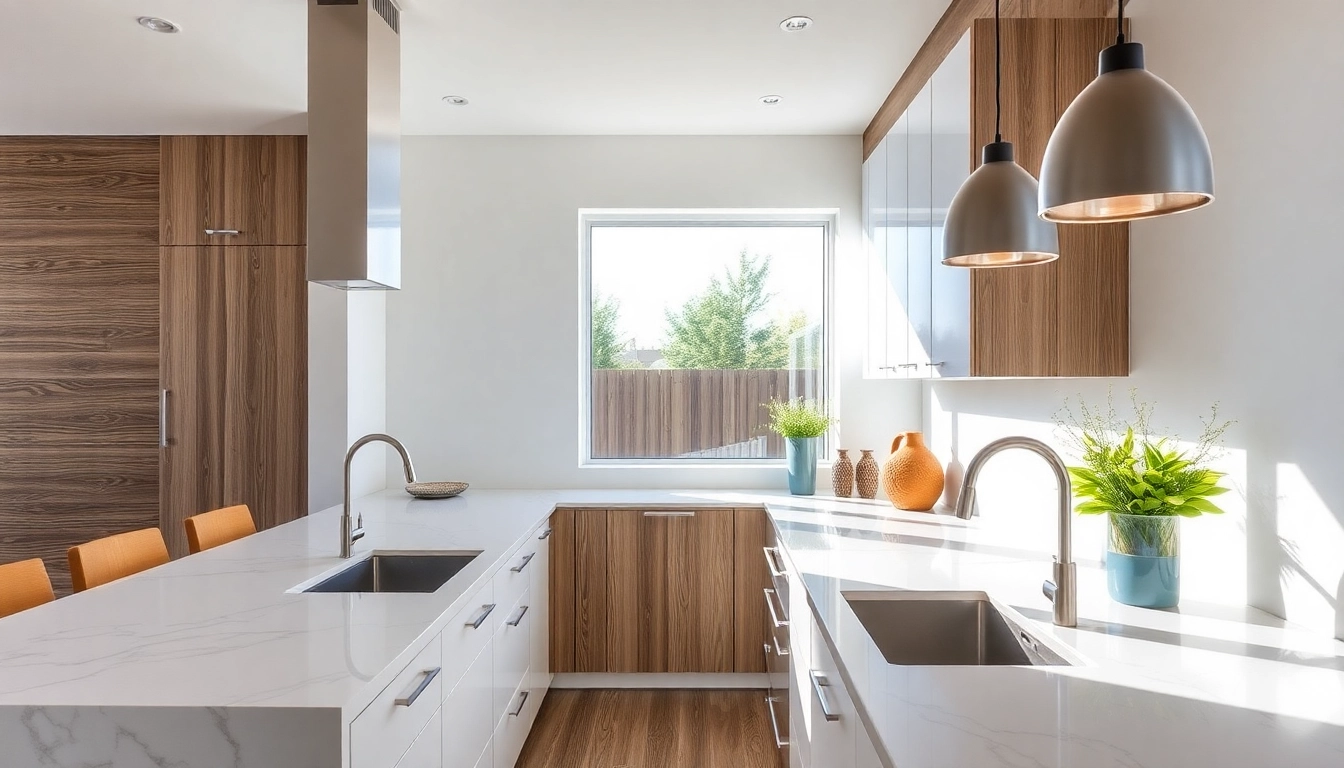Understanding Remodeling: What It Really Means for Your Home
Remodeling has become an essential aspect of maintaining and enhancing the value, functionality, and aesthetic appeal of residential spaces. It involves more than just cosmetic updates; remodeling encompasses comprehensive structural changes that transform the way your home functions and feels. Whether you’re looking to modernize your kitchen, expand your living space, or completely overhaul your home’s layout, understanding the core principles of remodeling is vital for a successful project. For those considering embarking on such a journey, it’s crucial to grasp what remodeling truly entails and how it can benefit your property and lifestyle. Visit Remodeling providers for expert assistance and insights.
Defining Remodeling and Its Scope
At its core, remodeling refers to the process of changing or altering the structure, style, or configuration of a building or space. Unlike simple repairs or cosmetic upgrades, remodeling typically involves significant modifications that may include structural alterations, layout redesigns, and system upgrades. The scope of remodeling can range from minor aesthetic improvements, such as new paint and fixtures, to major renovations that involve tearing down walls, installing new plumbing or electrical systems, and reconfiguring spaces for better functionality.
The primary goal of remodeling is to improve the home’s usability, address changing needs, increase property value, and reflect current design trends. It’s a proactive approach to ensure your home evolves along with your lifestyle or adapts to new standards for energy efficiency and sustainability.
According to the Collins Dictionary, remodeling involves “the act of changing or altering the structure, style, or form of something,” emphasizing its transformational nature. Whether you want to convert a basement into a family room or reconfigure a dated kitchen into a contemporary culinary space, remodeling provides the tools and strategies for those transformations.
Common Types of Remodeling Projects
Kitchen Remodeling
Often cited as the most valuable upgrade, kitchen remodeling includes updating appliances, cabinets, countertops, and flooring. It’s about creating a functional, inviting space that caters to modern needs—such as open-concept layouts and smart technology integrations. For example, upgrading to energy-efficient appliances and adding an island for additional workspace enhances both usability and aesthetic appeal.
Bathroom Renovations
This involves replacing fixtures, improving ventilation, installing modern vanities, and upgrading plumbing. Luxury features like steam showers, radiant floor heating, and frameless glass enclosures are growing in popularity, creating spa-like retreats within your home.
Basement Finishing and Conversion
Transforming unfinished basements into livable spaces adds significant square footage and functionality. Whether it’s creating an entertainment area, an extra bedroom, or a home office, basement remodels often require addressing moisture issues and improving insulation.
Open Floor Plan and Space Optimization
Removing walls and reconfiguring layouts can make homes feel more spacious and improve traffic flow. This approach aligns with modern living preferences and is particularly popular in urban areas where space is limited.
Structural and System Upgrades
These projects involve foundation repairs, roof replacements, electrical rewiring, and HVAC system updates—ensuring the home meets current safety standards and energy efficiency requirements.
Benefits of Professional Remodeling vs. DIY
While DIY projects may seem appealing for their cost-saving potential, professional remodeling offers numerous advantages that often outweigh the initial savings. Skilled contractors bring expertise in planning, permitting, safety standards, and technical execution, minimizing risks and mistakes. Experts are also adept at sourcing quality materials, adhering to local codes, and managing timelines effectively.
For example, a professional remodel can significantly increase your home’s value and lifespan. According to industry data, professional renovations tend to yield higher returns at sale—up to 70-80% of the project’s cost, in many cases. Moreover, they can help navigate complex legal requirements and coordinate the many trades involved in a comprehensive project.
Conversely, DIY remodeling may lead to costly errors, safety hazards, and the need for rework. It’s suitable for small, straightforward tasks—such as painting or installing fixtures—but complex projects benefit greatly from experienced professionals, ensuring a seamless, high-quality outcome.
Planning Your Remodeling Project: Steps to Success
Setting Realistic Goals and Budget
The foundation of any successful remodeling project is clear goal setting aligned with your budget. Begin by prioritizing your needs—what spaces require the most attention? Are you aiming for increased functionality, aesthetic appeal, or energy efficiency? Establishing a realistic budget helps prevent overextending financially and guides material and design choices.
Industry experts recommend allocating an additional 10-20% of your initial budget for unforeseen expenses, which are common due to the unpredictable nature of remodeling projects.
Designing a Cohesive Style and Layout
Creating a design plan that reflects your personality while maintaining coherence across spaces is essential. Consulting with professional designers or using digital visualization tools can help visualize the final look and make necessary adjustments early. Consider color schemes, material textures, lighting, and furniture layouts that complement your home’s architecture and your lifestyle.
Choosing the Right Contractors and Materials
Vet potential contractors thoroughly by examining portfolios, references, and reviews. Select those with proven experience in your project type and ensure they are licensed, insured, and bonded. Additionally, sourcing high-quality, durable materials—whether eco-friendly options or luxury finishes—can impact the longevity and appeal of your remodeling investments.
Best Practices for a Seamless Remodeling Experience
Scheduling and Timeline Management
Develop a detailed schedule that includes project milestones, delivery dates, and contingency plans for delays. Effective communication with your contractor ensures alignment and flexibility. Keeping a project timeline updated minimizes disruptions and helps track progress.
Permits, Codes, and Regulations
Understanding local building codes and obtaining necessary permits are critical. Non-compliance can result in hefty fines, work stoppages, or the need to redo completed work. Engaging with licensed professionals familiar with regional requirements streamlines this process.
Managing Expectations and Communication
Transparent, ongoing communication fosters trust, reduces misunderstandings, and allows for timely adjustments. Regular site visits, progress reports, and clarification of scope changes are essential for maintaining a positive working relationship and ensuring the project aligns with your vision.
Innovative Ideas to Refresh Your Home’s Look through Remodeling
Modern Kitchen and Bath Upgrades
Incorporate smart technology, such as touchless faucets, LED lighting, and built-in appliances, for convenience and energy savings. Use contemporary materials like quartz countertops, matte black fixtures, and minimalist cabinetry to create sleek, functional spaces.
Open Floor Plans and Space Optimization
Knocking down non-load-bearing walls opens up living areas, enhances natural light, and improves social interaction. To balance openness with privacy, incorporate sliding doors, partial walls, or strategic furniture placement.
Eco-Friendly and Sustainable Materials
Choose eco-conscious options like bamboo flooring, recycled glass countertops, and low-VOC paints. Implement energy-efficient windows, insulation, and HVAC systems to reduce carbon footprint and long-term operational costs.
Measuring Success and Maintaining Your Renovation
Evaluating Project Outcomes
Assess the completed project against your initial goals. Did it improve functionality? Was the quality up to standards? Collect feedback from family members and even professional inspectors to ensure all aspects meet expectations and safety standards.
Maintenance Tips for Longevity
Regular upkeep—cleaning, inspections, and timely repairs—extends the life of your remodel. For instance, sealing grout lines, checking plumbing connections, and maintaining HVAC systems keep everything running efficiently.
Future Expansion and Upgrades
Plan for scalability and future upgrades by designing flexible spaces and leaving provisions for adding new features. Staying informed about emerging trends and technologies allows you to keep your home aligned with evolving needs and standards.

